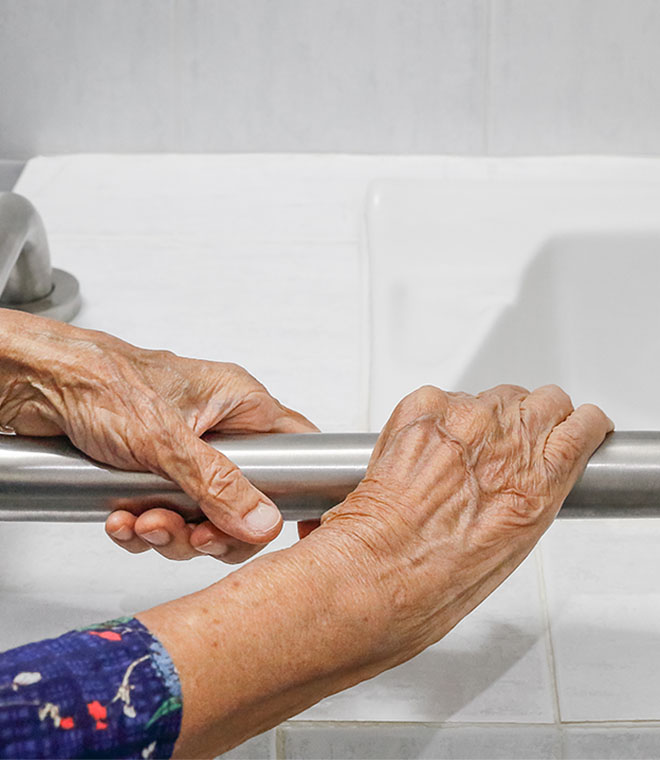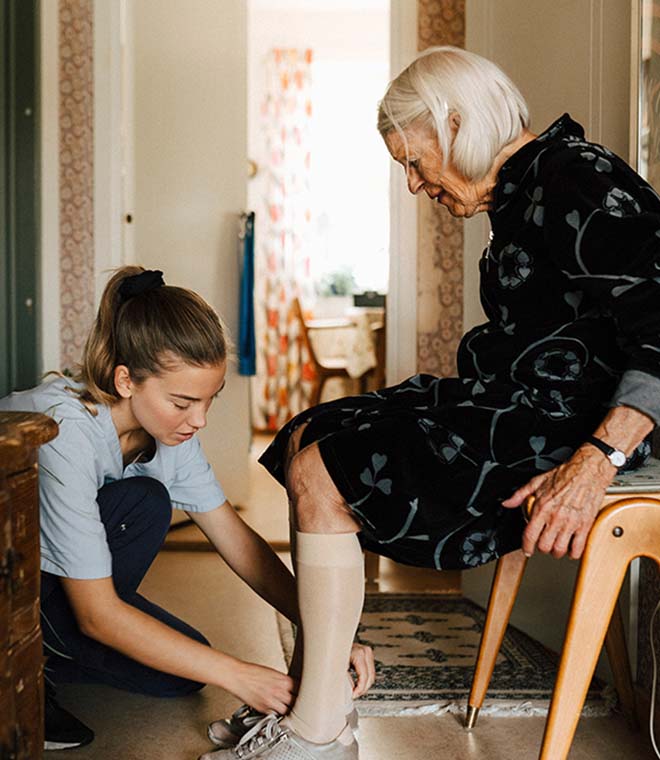Wellness
Incontinence: An overview for caregivers
By Walgreens Jun 30, 2022 • 10 min
Caring for someone with bladder or bowel control challenges can be overwhelming. If you're a caregiver, it can be helpful to learn about incontinence so you can better care for your loved ones.
What is incontinence?
Incontinence means the loss of control over bladder or bowel function. It can cause bothersome and embarrassing issues, such as involuntary leaking and not making it to the bathroom in time. Urinary incontinence is the term for loss of control over bladder function. Fecal incontinence and bowel incontinence are the terms for not being able to control bowel function.
Incontinence affects both men and women but the causes may be different. While it's also more common among older adults, incontinence should not be regarded as a normal part of aging. In many cases, it can be cured or controlled with appropriate treatment.
Types of incontinence
There are several types of urinary incontinence.
Women are affected the most by two types of urinary incontinence—stress incontinence and urge incontinence. Men are most affected by urge incontinence.
Stress incontinence causes urine to leak when jumping, sneezing, coughing, laughing or engaging in some other type of movement. This physical stress increases pressure on the bladder due to weakened pelvic and urethral muscles, which causes leakage of urine—usually only a small amount. This can often result from pregnancy and childbirth in women and surgery for prostate disease or a pelvic fracture in men. Frequent coughing due to emphysema, cystic fibrosis and other serious lung conditions may also lead to stress incontinence.
Urgency incontinence happens when someone has a strong need to urinate even when their bladder isn't full. At times, the urge may be difficult to control, which can cause urine to involuntarily leak. Urgency incontinence can stem from nerve damage from an accident, neurological issues, post-menopausal bladder changes or diabetes. But it can also be a common symptom or sign of a urinary tract infection (UTI). You should always seek medical attention for possible symptoms of a UTI in order to get appropriate and timely treatment, as a UTI can become serious. Note that some people refer to urgency incontinence as overactive bladder, though that is a slightly different condition. People with overactive bladder feel an urge to urinate, but don't necessarily leak urine.
Mixed incontinence refers to symptoms of both stress and urge incontinence. This condition appears more often in women or men who have had surgery for an enlarged prostate or prostate removal.
Overflow incontinence occurs when the bladder doesn't fully empty. Someone with this condition may have urine leakage without feeling the need to go. This can be caused by something physically blocking urine from coming out of the bladder, such as an enlarged prostate. It may also be caused by underactive bladder muscles, which can keep the person from feeling the urge to go. This can happen due to diabetes, heart disease or nerve damage (from childbirth, injury or surgery, for instance). Medications can also contribute to overflow incontinence.
Functional incontinence In this condition, the urinary tract works properly, but other challenges may keep someone from reaching the toilet in time. This can happen due to disabilities, mental illness, dementia or even medications.
Urinary incontinence treatment
The treatment your loved one needs depends on the type of urinary incontinence they have, how serious it is and what's causing their symptoms. Encourage them to work closely with their healthcare provider and follow their care plan as directed. Some urinary incontinence treatment options include:
Behavioral treatments, which may include:
Kegel exercises (pelvic floor strengthening exercises to help reduce leaking)
Bladder training (using the bathroom at set times)
Weight management
Managing fluid intake
Quitting smoking
Cutting back on certain foods and drinks that make symptoms worse; spicy foods, caffeine-containing beverages and alcohol can irritate the bladder
Medications may be prescribed for men and women to help treat the cause of incontinence, depending on the type.
Pessary devices are devices inserted into the vagina by a healthcare provider and are used to treat stress incontinence in women by helping support the bladder.
Nerve stimulation may be an option for individuals who haven’t responded to other treatments for urge incontinence. Mild electric impulses are used to stimulate the nerves around the bladder and contract the pelvic floor muscles.
Biofeedback is a technique that can help train the pelvic floor muscles to contract and relax properly using sensors to make a person aware of signals from the body to help control bladder function.
Surgery may also be an option for urinary incontinence when other treatments have failed to work.
Types of bowel incontinence
Bowel incontinence can be categorized as two types: urge incontinence and passive incontinence. People who are more at risk for developing bowel incontinence are those who are older in age, have diabetes mellitus, are on hormone therapy or are having urinary incontinence as well. Diarrhea and fecal urgency (feeling the need to have a bowel movement) can also contribute to a person having bowel incontinence.
Urge incontinence happens when a person has a sudden urge to have a bowel movement but cannot make it to the toilet in time. It often occurs with diarrhea.
Passive incontinence occurs when stool is leaked but the individual is unaware or does not feel the urge to have a bowel movement.
Bowel incontinence treatment
Bowel incontinence can be caused by many different factors, such as nerve damage, hemorrhoids or diarrhea. A visit to your loved one’s healthcare provider can help determine the cause and the best treatment plan to help their symptoms. Some treatment options can include:
Medications as prescribed or directed by a healthcare provider, such as anti-diarrheal drugs or bulk laxatives for constipation.
Kegel exercises may help incontinence by strengthening pelvic floor muscles that support the bladder, bowel and uterus.
Bulking agent injections can be administered by a healthcare provider to thicken the walls of the anus with the aim to prevent leakage.
Sacral nerve stimulation (SNS) can be given by implanting a device that sends small electrical impulses to nerves, which can strengthen bowel muscles.
Vaginal balloon (Eclipse System) can lessen episodes of bowel incontinence using a pump-type device to increase pressure on the rectum.
Radiofrequency therapy (Secca procedure) is a minimally invasive procedure that delivers temperature-controlled radiofrequency energy to improve muscle tone of the anal walls.
Surgery may be another option to repair any bowel conditions or injuries that are causing symptoms.
Incontinence products
There is a wide variety of incontinence supplies available on the market. While these products don't treat incontinence, they may help the person you care for feel more comfortable:
Pads and liners. Incontinence pads and liners stick to underwear.
Protective underwear and briefs. Disposable and reusable absorbent underwear offers protection in case of leaks.
Cloths and wipes. Using cloths and wipes after using the restroom can help keep skin clean and dry. Some wipes have ingredients meant to help soothe any existing skin irritation.
Cleansers, creams and lotions. Skin that is in constant contact with urine or stool can become irritated and painful. Using a mild cleanser after using the bathroom can help clean the skin. Barrier creams can help protect the skin, while moisturizers can be used to improve excessive skin dryness from irritation.
Bedding protection. Disposable and reusable bedding liners, pads and covers can protect beds and other furniture in case of an accident.
Bedpans and urinals. These products allow people with limited mobility to use the toilet without traveling to the bathroom. After use, bedpans and urinals can be emptied, cleaned and reused.
Use all incontinence products according to the directions provided on the package. You can talk to your loved one's doctor or pharmacist about recommendations for incontinence symptoms and challenges. They can give you more information about different incontinence product options available based on your loved one’s specific needs.
Clinically reviewed and updated by Julie McDaniel, MSN, RN, CRNI, June 2022.
Sources:
- https://www.niddk.nih.gov/health-information/digestive-diseases/bowel-control-problems-fecal-incontinence/definition-facts
- https://www.womenshealth.gov/a-z-topics/urinary-incontinence
- https://medlineplus.gov/urinaryincontinence.html
- https://www.uptodate.com/contents/urinary-incontinence-in-women-beyond-the-basics
- https://medlineplus.gov/ency/article/001270.htm
- https://www.uptodate.com/contents/urinary-incontinence-treatments-for-women-beyond-the-basics
- https://medlineplus.gov/ency/article/003976.htm
- https://www.webmd.com/urinary-incontinence-oab/urge#1
- https://www.nia.nih.gov/health/urinary-incontinence-older-adults
- https://www.mayoclinic.org/diseases-conditions/fecal-incontinence/symptoms-causes/syc-20351397
- https://www.medicalnewstoday.com/articles/stress-incontinence#causes
- https://www.urologyhealth.org/urology-a-z/o/overactive-bladder-(oab)
- https://www.auanet.org//education/auauniversity/for-medical-students/medical-students-curriculum/medical-student-curriculum/urinary-incontinence
- https://www.medscape.com/answers/459340-98776/which-medications-in-the-drug-class-beta3-adrenergic-agonists-are-used-in-the-treatment-of-overactive-bladder
- https://www.uptodate.com/contents/fecal-incontinence-in-adults-etiology-and-evaluation
- https://www.uptodate.com/contents/fecal-incontinence-in-adults-management
- https://www.mayoclinic.org/diseases-conditions/fecal-incontinence/diagnosis-treatment/drc-20351403



